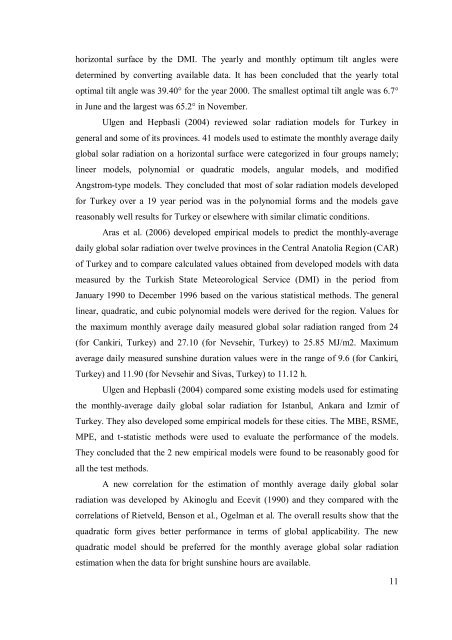measurement and comparison of solar radiation estimation models ...
measurement and comparison of solar radiation estimation models ...
measurement and comparison of solar radiation estimation models ...
Create successful ePaper yourself
Turn your PDF publications into a flip-book with our unique Google optimized e-Paper software.
horizontal surface by the DMI. The yearly <strong>and</strong> monthly optimum tilt angles were<br />
determined by converting available data. It has been concluded that the yearly total<br />
optimal tilt angle was 39.40° for the year 2000. The smallest optimal tilt angle was 6.7°<br />
in June <strong>and</strong> the largest was 65.2° in November.<br />
Ulgen <strong>and</strong> Hepbasli (2004) reviewed <strong>solar</strong> <strong>radiation</strong> <strong>models</strong> for Turkey in<br />
general <strong>and</strong> some <strong>of</strong> its provinces. 41 <strong>models</strong> used to estimate the monthly average daily<br />
global <strong>solar</strong> <strong>radiation</strong> on a horizontal surface were categorized in four groups namely;<br />
lineer <strong>models</strong>, polynomial or quadratic <strong>models</strong>, angular <strong>models</strong>, <strong>and</strong> modified<br />
Angstrom-type <strong>models</strong>. They concluded that most <strong>of</strong> <strong>solar</strong> <strong>radiation</strong> <strong>models</strong> developed<br />
for Turkey over a 19 year period was in the polynomial forms <strong>and</strong> the <strong>models</strong> gave<br />
reasonably well results for Turkey or elsewhere with similar climatic conditions.<br />
Aras et al. (2006) developed empirical <strong>models</strong> to predict the monthly-average<br />
daily global <strong>solar</strong> <strong>radiation</strong> over twelve provinces in the Central Anatolia Region (CAR)<br />
<strong>of</strong> Turkey <strong>and</strong> to compare calculated values obtained from developed <strong>models</strong> with data<br />
measured by the Turkish State Meteorological Service (DMI) in the period from<br />
January 1990 to December 1996 based on the various statistical methods. The general<br />
linear, quadratic, <strong>and</strong> cubic polynomial <strong>models</strong> were derived for the region. Values for<br />
the maximum monthly average daily measured global <strong>solar</strong> <strong>radiation</strong> ranged from 24<br />
(for Cankiri, Turkey) <strong>and</strong> 27.10 (for Nevsehir, Turkey) to 25.85 MJ/m2. Maximum<br />
average daily measured sunshine duration values were in the range <strong>of</strong> 9.6 (for Cankiri,<br />
Turkey) <strong>and</strong> 11.90 (for Nevsehir <strong>and</strong> Sivas, Turkey) to 11.12 h.<br />
Ulgen <strong>and</strong> Hepbasli (2004) compared some existing <strong>models</strong> used for estimating<br />
the monthly-average daily global <strong>solar</strong> <strong>radiation</strong> for Istanbul, Ankara <strong>and</strong> Izmir <strong>of</strong><br />
Turkey. They also developed some empirical <strong>models</strong> for these cities. The MBE, RSME,<br />
MPE, <strong>and</strong> t-statistic methods were used to evaluate the performance <strong>of</strong> the <strong>models</strong>.<br />
They concluded that the 2 new empirical <strong>models</strong> were found to be reasonably good for<br />
all the test methods.<br />
A new correlation for the <strong>estimation</strong> <strong>of</strong> monthly average daily global <strong>solar</strong><br />
<strong>radiation</strong> was developed by Akinoglu <strong>and</strong> Ecevit (1990) <strong>and</strong> they compared with the<br />
correlations <strong>of</strong> Rietveld, Benson et al., Ogelman et al. The overall results show that the<br />
quadratic form gives better performance in terms <strong>of</strong> global applicability. The new<br />
quadratic model should be preferred for the monthly average global <strong>solar</strong> <strong>radiation</strong><br />
<strong>estimation</strong> when the data for bright sunshine hours are available.<br />
11

















